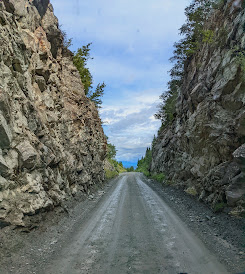It's no surprise that the largest state in the United States is also home to the largest national park ... Wrangell-St Elias National Park. Along with Denali and Kenai Fjords, Wrangell-St Elias is the other national park in Alaska that is accessible by automobile. Boat or plane needed in order to visit the other five. And, as we soon found out, while the roads leading into the park can be a bit challenging, the history and natural beauty that awaits inside the park is worth the journey.
We caught a small glimpse of the 13.2 million acres that make up Wrangell-St Elias National Park when we were on our way down to Valdez. It is often called ''The Mountain Kingdom of North America'' because nine of the sixteen highest mountain peaks in the US are located in this national park ... including Mount St Elias, the second highest mountain in the United States. And because this national park borders Glacier Bay National Park as well as two Canadian national parks, the combined 24 million acres makes up the largest transboundary protected area in the world.
Mount Wrangell, an active volcano, and rows of other snow-capped beauties arose to greet us as we drove along the Richardson Highway towards Valdez. We stopped to find out more about this national park at the Copper Center Visitor Center, located alongside this highway. There we learned that in addition to being home to massive mountain peaks, glaciers, and ice fields, Wrangell-St Elias also has an interesting historical side. Those brave (or crazy) enough to travel down the McCarthy Road, will be rewarded with chance to visit the well-preserved remnants of an early 20th century copper mining community.
How bad can this narrow, twisty, gravel road be??
Not bad at all as long as we take it slow, and our tires don't happen to find any railroad spikes leftover from the days when this 62 mile road served as the train route from the copper mines to the shipping port 200 miles away.
Bridges over river gorges provided beautiful scenery for us,
... but we could only imagine how the harsh Alaskan weather and terrain would have made it a challenge for the early prospectors to reach their destination, the mountains near Kennicott Glacier.
Yes, as early explorers discovered, the green layer of stone was actually an abundant supply of valuable copper embedded in the limestone of those mountains!
Backed by some wealthy investors, Kennecott Copper Corporation mined one of the world's richest sources of copper beginning in 1907. The area exploded with activity as fortunes were quickly made. But just as quickly, the demand and price of copper fell, and the mines and towns were abandoned in 1938. Fortunately, the buildings held up fairly well over time and today are being preserved in Wrangell-St Elias National Park as the Kennecott Mines National Historic Landmark.
Many of the buildings have been restored for the public to view.
Others, like the 17-story concentration mill are open only through private tours. I wanted to learn more about the history of this town in the middle of nowhere, so for a $28 admission, we got to see and hear ''the rest of the story.''
Our guide, Gabe, entertained us for two hours with the history of the town as well as the mechanics of the mines and concentration mill. He explained how the crushing, leaching and floatation devices worked to extract 98% of the copper embedded in the surrounding rock.
Historical and engineering discussions
were enjoyed by all!
The copper was then transported in pure form via the Copper River & Northwestern (CR&NW) railroad 200 miles south to the seaport at Cordova, Alaska. It was then shipped to Tacoma, Washington where it was further processed and sold as important metal that was in demand in the expanding building and automobile industries. During the 31 years of operation, the owners made around $100 million in profit ... which translates to about $3 billion in today's dollars.
With so much profit to be made, the mine's owners spared no expense in making sure that they could get the copper to market. The CR&NW rail line that transported the copper through the harsh Alaskan wilderness was completed in just four years time. It was still, however, jokingly referred to as the ''Can't Run & Never Will'' railroad because of all the challenges it faced operating year-round in the cold, snowy Alaskan wilderness.
Five miles down the road, the town of McCarthy sprang up and provided the ''fun'' aspects of life for the miners in the form of diners, theaters, and saloons.
Today much of the town of McCarthy has also been restored and serves as the tourism hub for the area. The town's buildings remind visitors of this area's historical past.
While the history of this area abounds, it is the surrounding beauty of Wrangell-St Elias National Park that truly rewards you for venturing the 62 miles on the challenging McCarthy Road.
The Root Glacier Trail led us from the Kennecott Mill along a rocky path left by the retreating glacier. If we would have had crampons, we could have joined the other hikers walking on the glacier. But after seeing the downhill (and then uphill) climb, we were happy to just enjoy our view from the trail,
... and later from our campsite.
Although the roads are challenging and access is limited, a visit to Wrangell-St Elias National Park is filled with enormous rewards in the form of historical and natural beauty.








.jpg)

.jpg)


.jpg)

.jpg)





No comments:
Post a Comment